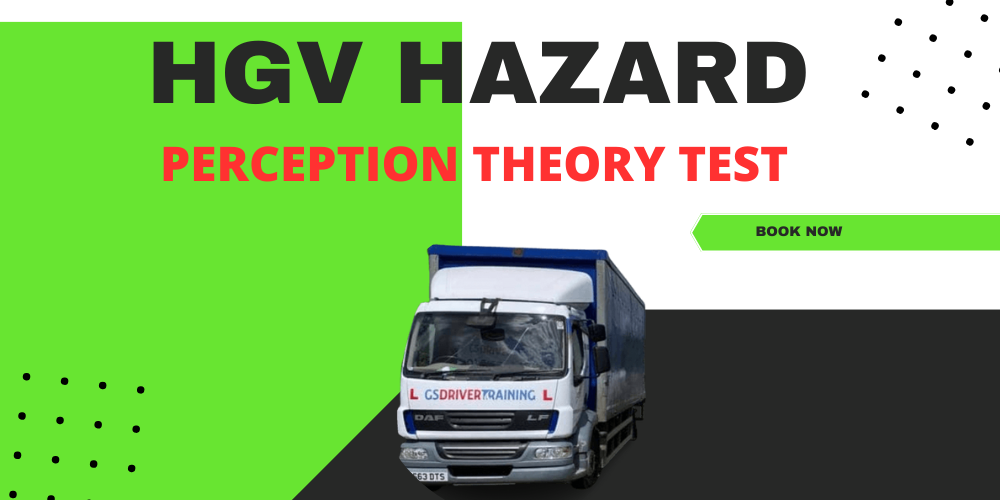HGV Hazard Perception Theory Test with Some Passing Strategies
Driving an HGV while taking a hazard perception test meant for car drivers may appear strange at first. People often think that hazard perception is just to show their potential, but in reality, HGV hazard perception tests are all about indicating errors on time.
GS Driver Training the leading driving centre in UK is providing reliable services to their customers in which a variety of packages are included. You can easily get in touch with us, we have an experienced team who ensures to provide the best training at a very affordable price.
What Comes Under the Hazard Perception Test
If you are going for the Hazard Perception test then make sure that you have to pass the theory test as well as the CPC test. Moreover, the most important thing is that the HGV hazard perception test is valid for two years only.
Hazard Perception Test: Passing Strategies
A commercial driver’s licence is necessary for the lawful and safe operation of commercial vehicles, which typically transport either passengers or products. Large vans and buses, as well as other heavy-duty vehicles, fall under this category. The following are the minimal prerequisites to work as a Commercial HGV truck driver in the United Kingdom:
1.You have to be at least eighteen.
2.Your valid UK driver’s licence is required.
3.To operate a heavy-duty vehicle (HLV), you must be in good medical health and pass an HGV medical examination administered by a physician who has been approved by the Driver and Vehicle Standards Agency (DVSA).
4.To drive a goods vehicle, you need a provisional licence for that class of vehicle.
5.A theoretical test on HGVs is required.
6.An HGV Hazard Perception test must be passed.
7.You have to clear an HGV off-road exam.
8.An HGV practical on-road exam must be passed.
9.To drive for hire, you need a Driver Certificate of Professional Competence (CPC).
Once you fulfil all of these prerequisites, you can apply to work as an HGV truck driver. You should be able to locate a job that fits your needs and interests because so many different logistics firms and organisations employ HGV drivers.
Some Important Steps to Get the Commercial Driver Licence
- Commercial driver’s licences go into various categories in the UK: C, C1, C+E, C1+E, D1, and D. To be granted one of these particular licences, you also need to fulfil requirements and clear exams. Choosing your next course of action depends critically on the type of business driver’s licence you require.
- The application process for provisional driving privileges is the next step toward obtaining a Commercial driver’s licences. However, before obtaining the Commercial driver’s , you must possess a current UK driver’s licence.
- After that, you’ll get a Driver CPC card, which is necessary for driving buses, coaches, and trucks in a professional capacity.
- Every five years, you must complete 35 hours of periodic training to keep your certification current.
Some Provisional Entitlements
1.When a vehicle is hauling a trailer that weighs close to 3,500 kg, a BE licence is required.
2.Riding a road roller is permitted with a G licence.
3.Tracked vehicles can use the H licence.
4.Driving a vehicle weighing between 3,500 and 7,500 kg (with a caravan up to 750 kg) is possible with a C1 licence.
5.Driving a car over 3,500 kg (with a caravan up to 750 kg) requires a C licence.
6.Your D1 licence. allows you to operate mini buses with a maximum passenger capacity of 16 and a maximum length of 8 metres (with a trailer weighing up to 750 kg).
7.A D licence is required for bus drivers who transport more than eight people and a 750 kg trailer.
About CPC (Certificate of Professional Competence)
You must take the Driver Certificate of Professional Competence (CPC) exam to obtain your Driver CPC card (certificate of Professional Competence). A
theory test is the first component of the same. There are two forms of the theoretical test. both the Hazard Perception Test and the MCQ Test.
The seven case studies of the Case Studies Driver CPC test, which is also administered on a computer, have six to eight questions per case study.
The case studies mirror the situations you are likely to encounter in your daily driving, and each evaluation takes thirty minutes to complete.
The Driver CPC Case Study and the Practical Test are the next things you must do. A practical demonstration test wraps up the Driver CPC. To schedule it, you need to have passed the case studies exam. This test covers your ability to secure your car, load it safely, stop the trafficking of illegal immigrants, and other related skills.
Hazard Perception Test: Passing Strategies
1.Drivers with more experience generally recognise hazards faster and sometimes even before the system does. You may get less credit for this. When you spot the hazard at the proper moment, you get five marks; but, if you spot it too early or too late, you can get fewer points—four, three, two, or sometimes one.
2.You should be informed before you begin that there is no way to pause or resume any of the video clips; this is done to replicate the necessity of being alert when driving.
3.Be advised that clicking continuously or rhythmically will result in your disqualification and exam failure. Furthermore, if you simply click once, it’s possible that you missed any possible dangers in the video.
Frequently Asked Questions
What is the What is the UK theoretical test for Hazard Perception?
The second portion of your driving theory test is called the Hazard Perception Test. It consists of fourteen or fifteen video segments that depict commonplace situations you could come into while driving. All vehicle types take the same HPT test, although there are differences in the quantity of questions and video clips.
How should I get ready for the UK Hazard Perception Test?
1.Understand what a risk is.
2.Try out a practice exam.
3.Keep an eye out.
4.Avoid clicking excessively.
5.Keep an eye out for traffic signs.
6.There will be two risks in one clip, not simply one.
How Many Clicks are allowed in the Hazard Perception Test UK?
Click the mouse as soon as you notice the hazard beginning to develop if you want a high score. If you click and make a mistake, you do not lose points. But if you click in a certain way or often, you won’t get any points. You can only try each clip once.The second portion of your driving theory test is called the Hazard Perception Test. It consists of fourteen or fifteen video segments that depict commonplace situations you could come into while driving. All vehicle types take the same HPT test, although there are differences in the quantity of questions and video clips.
How should I get ready for the UK Hazard Perception Test?
Understand what a risk is.
Try out a practice exam.
Keep an eye out.
Avoid clicking excessively.
Keep an eye out for traffic signs.
There will be two risks in one clip, not simply one.
How Many Clicks are allowed in the Hazard Perception Test UK?
Click the mouse as soon as you notice the hazard beginning to develop if you want a high score. If you click and make a mistake, you do not lose points. But if you click in a certain way or often, you won’t get any points. You can only try each clip once.
How long is the validity of the UK driving theory test?
Your pass certificate number is valid for two years if you pass. If you fail the driving test during that period, you will need to retake the theory exam.
Can I click “Hazard Perception” ten times?
Don’t click on a single clip more than five or ten times. Only click when a danger is detected. To confirm that you clicked anywhere inside the marking zone, click again a little while later. As soon as you spot a danger, click.
Also Read: All About the Midas Driver Training








